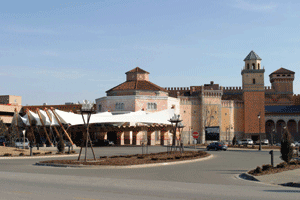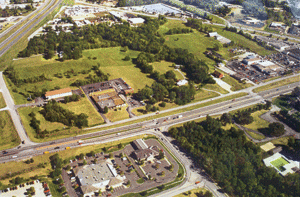In the automotive age, a successful crossroads requires more than the mere intersection of two highways. It requires the capability to handle the cars that descend there. When developers built on the greenfields of Johnson County, they built to accommodate the automobile in a psychologically friendly way. J.C. Nichols did the same when he built on the greenfields of Brush Creek a half-century prior.
It remains to be seen whether Downtown Kansas City can handle the auto traffic its new facilities will attract. Suburban drivers find its subterranean streets and multi-storied parking lots intimidating. The success of the Downtown revival will hinge, however, on adapting to the expectations of suburbanites. Historically, downtowns everywhere have expected customers to adapt to the limitations of the downtown. This does not happen in a city with multiple crossroads.
Up The River For years, ever since the last horse ran at "Pendergast Downs," the city of Riverside, Missouri has languished in quiet obscurity. This is all about to change. A convergence of two infrastructure refinements is turning Riverside into a viable crossroads.

The Argosy Casino
The Argosy Casino figured this out when it placed its highly visible casino at the relatively new and easily accessible intersection of I-635 and Missouri Highway 9, a divided highway at that juncture. The infusion of Argosy tax money has enabled Riverside to pursue other projects, none more significant than the new Riverside Levee (L-385), a project that will protect the riverfront area from floods and thus greatly enhance its commercial value.
Ground was broken on the anticipated three-year project two years ago. It is expected to cost about $70 million, half of which will be picked up by the U.S. Corps of Engineers and half by the levee district. The area had been protected only by an agricultural levee, just two to 10 feet in height. The levee could not contain the notorious 1993 flood, which covered 1300 acres--an area half the size of nearby North Kansas City. That flood closed nearly 70 businesses and put more than 5,000 people out of work for many months.

The City of Riverside has utilized tax funds from the Argosy Casino to develop a project that drastically enhances the value of the community.
Development of these reclaimed acres could result in an estimated 11,000,000 square feet of industrial, retail and commercial space. With the Argosy funding infrastructure refinements, and with two major airports within easy reach, Riverside could become a truly powerful commercial and industrial hub.
It took a while for city planners to understand that a single strand of highway, no matter how attractive, would not necessarily lure commerce along the route. Before the truth became clear, they watched I-29 north from downtown to the airport sit in nearly isolated splendor for years. What was desperately needed in Platte County were east-west roads that could deliver traffic smoothly to I-29. The county's lovely riverside topography has made this difficult but a top priority for county planners. Major improvements to Missouri Highways 45 and 152 have helped turn priority into reality.
Still, progress demands more progress. Among the projects underway now is $50 million in road construction between Barry Road and Tiffany Springs Parkway on both the east and west sides of I-29. These improvements are critical because sitting on the northwest corner of the Barry Road and I-29 intersection is Zona Rosa, easily the most ambitious retail project in Platte County history. For the county officials to keep their independent-minded constituents happy they are going to have to keep the east-west traffic flowing smoothly.
Give Me Liberty Clay County officials face challenges not at all dissimilar to their Platte County colleagues. The county has exceptional north-south interstate capabilities. Few counties any-where have better. I-29 scoots through North Kansas City before heading west to Platte. I-435 runs north through the heart of it before turning west towards KCI, and I-35 bisects the county on a northeast axis.
Like Platte County, Clay is not nearly as strong east to west, and that is where current infrastructure emphasis lies. Improvements to U.S. Highway 69 northeast out of Liberty will make Excelsior Springs more accessible. This will also improve access to nearby Clay County Regional Airport, which is undergoing infrastructure improvements of its own. A $7.5 million runway expansion will soon allow the airport to accommodate jet cargo aircraft.
South of Liberty plans are finally taking shape for a new four-mile South Liberty Parkway that will connect I-35 and Missouri Highway 291 and open the southern part of Liberty to new development. This will be a divided four-lane, 45-mph parkway. Planners understand that this road is to be more than a bypass. By creating crossroads at either end of the four miles in a relatively affluent developing area, they consciously eye the creation of a Zona Rosa type lifestyle center in the project's second phase.

Development at the "Liberty Triangle" at the crossroads of I-35 and 291 is currently under development. This region has all the makings to become a "lifestyle center", similar to one at Zona Rosa at the Intersection of I-29 and Barry Road.
North Kansas City meanwhile is investing heavily in another kind of infrastructure, namely fiber optic cable right to its businesses. North Kansas City is playing into Kansas City's well-deserved reputation for telecommunications infrastructure. This has made the area highly attractive for telecom, call center, and database companies.
Kansas City, in fact, ranked fifth among 50 markets for the percentage of broadband Internet users, according to comScore Networks Inc. This new infrastructure ties into an old one, rail. Kansas City is America's second leading rail center after Chicago. Much of the nation's fiber cable runs along rail right of ways, and much of that passes through Kansas City. In turn, the development of the Internet has, at least to a limited degree, lessened the need for automotive travel.
Go West, Young Man By exploiting the huge crossroads potential at the juncture of I-435 and 1-70, Wyandotte County re-jiggered the power dynamics of the entire metropolitan area. Now, surrounding counties and cities look for ways to feed off the energy created there by the new Kansas Speedway and Village West projects.
